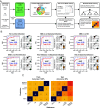Plasma cell-free RNA signatures of inflammatory syndromes in children
- PMID: 39240972
- PMCID: PMC11406294
- DOI: 10.1073/pnas.2403897121
Plasma cell-free RNA signatures of inflammatory syndromes in children
Abstract
Inflammatory syndromes, including those caused by infection, are a major cause of hospital admissions among children and are often misdiagnosed because of a lack of advanced molecular diagnostic tools. In this study, we explored the utility of circulating cell-free RNA (cfRNA) in plasma as an analyte for the differential diagnosis and characterization of pediatric inflammatory syndromes. We profiled cfRNA in 370 plasma samples from pediatric patients with a range of inflammatory conditions, including Kawasaki disease (KD), multisystem inflammatory syndrome in children (MIS-C), viral infections, and bacterial infections. We developed machine learning models based on these cfRNA profiles, which effectively differentiated KD from MIS-C-two conditions presenting with overlapping symptoms-with high performance [test area under the curve = 0.98]. We further extended this methodology into a multiclass machine learning framework that achieved 80% accuracy in distinguishing among KD, MIS-C, viral, and bacterial infections. We further demonstrated that cfRNA profiles can be used to quantify injury to specific tissues and organs, including the liver, heart, endothelium, nervous system, and the upper respiratory tract. Overall, this study identified cfRNA as a versatile analyte for the differential diagnosis and characterization of a wide range of pediatric inflammatory syndromes.
Keywords: cell-free RNA; diagnostics; inflammation; machine learning; pediatrics.
Conflict of interest statement
Competing interests statement:C.J.L and I.D.V are inventors on submitted patents pertaining to cell-free nucleic acids (US patent applications 63/237,367 and 63/429,733). I.D.V. is listed as an inventor on submitted patents pertaining to cell-free nucleic acids (US patent applications 63/237,367, 63/056,249, 63/015,095, 16/500,929, 41614P-10551-01-US) and receives consulting fees from Eurofins Viracor. C.A.R. has received institutional support from ModernaTX, Inc., Pfizer Inc., BioFire Inc., GSK plc, MedImmune, Micron Technology Inc., Janssen Pharmaceuticals, Merck & Co., Inc., Novavax, PaxVax, Regeneron, and Sanofi Pasteur. She is co-inventor of patented RSV vaccine technology which has been licensed to Meissa Vaccines, Inc. C.Y.C. receives grant funding for research unrelated to this work from the Bay Area Lyme Disease Foundation, the Chan-Zuckerberg Biohub, and Abbott Laboratories, Inc.
Figures





Update of
-
Plasma Cell-free RNA Signatures of Inflammatory Syndromes in Children.medRxiv [Preprint]. 2024 Mar 8:2024.03.06.24303645. doi: 10.1101/2024.03.06.24303645. medRxiv. 2024. Update in: Proc Natl Acad Sci U S A. 2024 Sep 10;121(37):e2403897121. doi: 10.1073/pnas.2403897121. PMID: 38496479 Free PMC article. Updated. Preprint.
References
-
- Tan M., Lu Y., Jiang H., Zhang L., The diagnostic accuracy of procalcitonin and C-reactive protein for sepsis: A systematic review and meta-analysis. J. Cell. Biochem. 120, 5852–5859 (2019). - PubMed
-
- Habgood-Coote D., et al. , Diagnosis of childhood febrile illness using a multi-class blood RNA molecular signature. Med. 4, 635–654.e5 (2023). - PubMed
MeSH terms
Substances
Supplementary concepts
Grants and funding
- R61HD105618/HHS | NIH | Eunice Kennedy Shriver National Institute of Child Health and Human Development (NICHD)
- R33HD105593/HHS | NIH | Eunice Kennedy Shriver National Institute of Child Health and Human Development (NICHD)
- R33 HD105618/HD/NICHD NIH HHS/United States
- R33HD105618/HHS | NIH | Eunice Kennedy Shriver National Institute of Child Health and Human Development (NICHD)
- R33 HD105593/HD/NICHD NIH HHS/United States
LinkOut - more resources
Full Text Sources
Medical
Molecular Biology Databases

